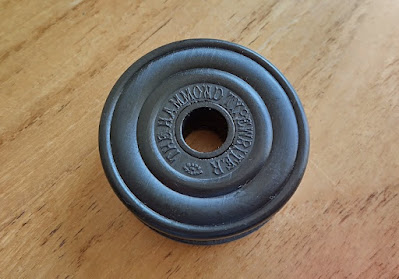Spools for the older models of the Hammond typewriter are quite large and made of hard-rubber flanges and a brass hub. Being as exposed on the machine as they are, and brittle too, many spools are broken with sometimes shards missing. That the paper-rest folds down right onto the edges of the spools also won't have helped.
They have a very distinctive design with textured and smooth areas and text around the hub - the spools are a noticeable element in the overall appearance of the Hammond.
Although one of the spools of the Multiplex was 'fixed' with card sections to make it usable, also wanted to try making 'whole' reproduction spools. One way is to make a press-mould from a good original side and then cast new flanges from e.g. sealing-wax or polymer clay - as shown in this video. However, first wanted to try 3D printing a new spool.
Taking measurements from an original, the flanges and hub were modelled in CAD. The lettering was traced manually over a scan of the spool in a vector-editing program. This traced drawing was then exported to CAD to create the raised lettering on the inner plane. A feature not (yet) modelled is the textures. (There is one extra difference between the CAD model and originals, one that'll make them readily identifiable as reproduction :-)
The parts were then ordered 3D printed in black resin. After getting the parts, they needed only minor sanding of the flange-holes to make the flanges a press-fit on the hub: a new Hammond typewriter spool!
With some more sanding, also the hub is a proper press-fit onto the capstans of the machine. In the image below, the reproduction spool is placed on the Hammond Multiplex (right capstan). Compared to the original spools there are differences, but overall the printed spool 'fits the machine'.
The resin printing process created a fine weaved-cloth-like texture over the whole part that actually works quite well. The outer and third 'rings' were lightly sanded. These 'rings' were then given a single coat of black paint to further smoothen and create a visual contrast with the texture of the second ring. This contrast is not as distinct as on the originals, but on the whole it's a credible impression of a Hammond ribbon spool.
This was a proof-of-concept for 3D printing reproduction spools. So far, conclusion of this test-print is that 3D-printing in resin seems to be a viable way to equip Hammond machines with replacement spools - and shortly will give this Multiplex spare spools :)





Another excellent solution! (:
ReplyDeleteNice!
ReplyDeleteYes the test-spool came out nicer than I'd expected! The typeshuttle however not so great, more testing to be done there :)
ReplyDelete